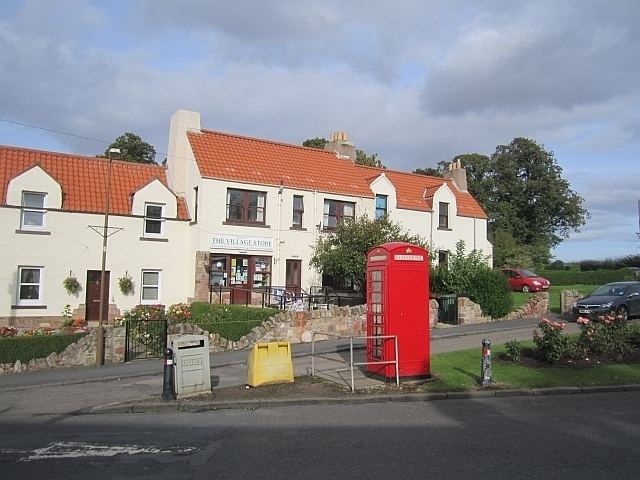OS grid reference NT467676 Post town TRANENT Dialling code 01875 | Civil parish Saltoun Sovereign state United Kingdom Postcode district EH34 Scottish parliament East Lothian | |
 | ||
Weather 5°C, Wind S at 8 km/h, 84% Humidity | ||
East Saltoun and West Saltoun are separate villages in East Lothian, Scotland, about 5 miles (8 kilometres) south-west of Haddington and 20 miles (32 kilometres) east of Edinburgh.
Contents
Geography
The villages of East Saltoun and West Saltoun, together with a large number of farms and hamlets, form the rural and mainly agriculture parish of Saltoun. The two villages lie in the foothills of the Lammermuirs, and are separated from each other by about one mile. To the south the villages are largely bordered by woodland: Petersmuir Wood, Dryden, and Saltoun Big Wood.
History
In the 12th century David I gifted lands in Saltoun to Hugh de Moreville. In 1643 the lands and barony were sold to Andrew Fletcher (grandfather of Andrew Fletcher, the Patriot), and it was the Fletcher family who attempted to make Saltoun a centre of manufacturing in the early 18th century. Most industry was sited in West Saltoun (formerly Milton), on the Birns Water. The first barley mill in Scotland was established there in 1712, and the British Linen Company had bleachfields in West Saltoun in 1746.
In the early 19th century the Fletcher family invested further in the parish by helping to pay for a new church, manse and school in East Saltoun, and commissioning additions to Saltoun Hall (near West Saltoun).
By the mid 19th century most of the parish's industries were failing, and the land was given over to agriculture.
East Saltoun
East Saltoun (once known as Kirkton) is the larger of the two villages.
A church dedicated to Saint Michael was first consecrated in 1244, and several church buildings have been used since then. Gilbert Burnet, theologian and Bishop of Salisbury, started his ministry in Saltoun in 1665. The present building dates back to 1805, and is built in the shape of a cross with a Gothic-style tower and steeple.
Local facilities include a garage, shop, village hall, blacksmith, and school. The school serves East Saltoun and West Saltoun, as well as the wider parish, and as of 2008 the roll was 49.
West Saltoun
At one time West Saltoun was larger, and had its own school, post office, and shop. Today, West Saltoun is smaller and is made up of just a few houses, with Saltoun Big Wood and the Birns Water nearby.
Infrastructure
The B6355 road runs through East Saltoun, connecting it to Gifford in the east, and Pencaitland in the north-west. A former branch railway line which linked East and West Saltoun to Gifford, Haddington and ultimately Edinburgh was closed to passengers in 1933 and is now a cycle path.
